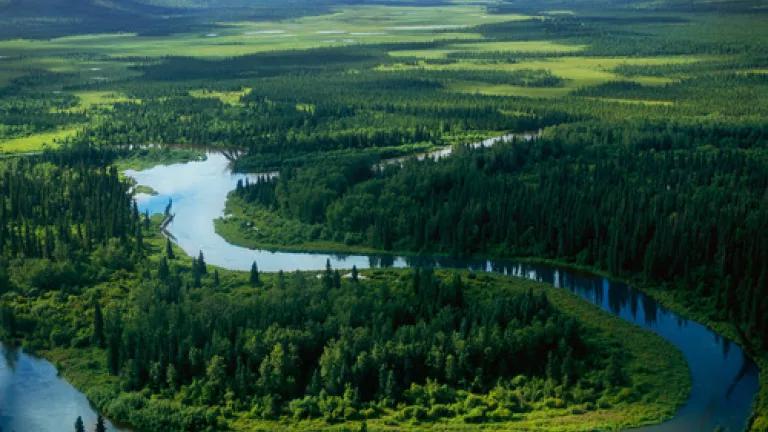
Today EPA released its final Bristol Bay Watershed Assessment, and the science is definitive: large-scale mining, like the Pebble Mine proposed at the headwaters of Bristol Bay, could potentially destroy the world’s greatest wild salmon fishery – and the people and wildlife that depend on the salmon.
EPA’s Watershed Assessment found that Pebble Mine would have significant impacts on fish populations and streams surrounding the mine site. Even without any accidents or failures (impossible for any large-scale mine), Pebble Mine would destroy up to 94 miles of streams and 5,350 acres of wetlands, ponds, and lakes – key habitat for a variety of fish species including tens of millions of sockeye salmon and the vast Southwest Alaskan ecosystem that these fisheries support. A tailings dam failure releasing toxic mine waste would have “catastrophic” effects on the ecosystem and region.
These conclusions are the culmination of three years of data review, scientific analysis, public hearings, peer review, and revision. EPA has taken every precaution to ensure that its assessment represents the best science regarding potential large-scale mining in the Bristol Bay watershed. In a process that far exceeds industry and academic standards of peer review, EPA’s Watershed Assessment has undergone two rounds of peer review during which 12 independent scientists reviewed the scope and content of the assessment and offered suggestions which EPA then incorporated into this final assessment. Furthermore, two rounds of public comment generated over 1.1 million individual comments. During the first comment period, over 90 percent of the 233,000 comments received supported EPA’s assessment. During the second comment period, over 650,000 people wrote to EPA explicitly supporting the Watershed Assessment and asking the agency to protect Bristol Bay; 73 percent of all comments, 84 percent of individual comments from within Alaska and a staggering 98 percent of individual comments from within Bristol Bay supported EPA action.
According to the Watershed Assessment, Bristol Bay’s wild salmon fishery provides 14,000 jobs and generated $480 million in direct economic expenditures in 2009. (A recent study estimated the fishery’s value at $1.5 billion annually.) Salmon also sustain the traditions and culture of Alaska Natives, who have relied on subsistence fishing for thousands of years.
But the proposed Pebble Mine would inevitably jeopardize this economic and cultural powerhouse. The Watershed Assessment concludes that mining at the headwaters of Bristol Bay would:
- Destroy spawning and rearing habitat, including up to 94 miles of streams.
- Devastate 5,350 acres of wetlands ponds, and lakes.
- Significantly impact fish populations in streams surrounding the mine site.
- Alter streamflows of up to 33 miles of salmon-supporting streams, likely affecting ecosystem structure and function.
- Create a transportation corridor to Cook Inlet crossing wetlands and approximately 64 streams and rivers in the Kvichak River watershed, 55 of which are known or likely to support salmon. Culvert failures, runoff, and spills of chemicals would put salmon spawning areas at risk.
- Require the collection, storage, treatment and management of extensive quantities of mine waste, leachates, and wastewater during mining and “long after mining concludes.”
In 2010, the Obama Administration recognized the unique importance of the region, barring offshore oil and gas exploration in Bristol Bay. Interior Secretary Ken Salazar described Bristol Bay as “a national treasure that we must protect” and “too special” to drill.
In today’s announcement, EPA reiterated the importance of Bristol Bay. We urge the agency to use this science-based information to protect the Bristol Bay watershed, its world-class salmon fishery, and the people, communities, commerce, and wildlife that depend on its salmon.
The science is in, and it’s definitive. Now is the time for EPA to use its authority under Section 404(c) of the Clean Water Act to protect Bristol Bay.
Show your support and stop the Pebble Mine.
Photo Credit: Robert Glenn Ketchum

